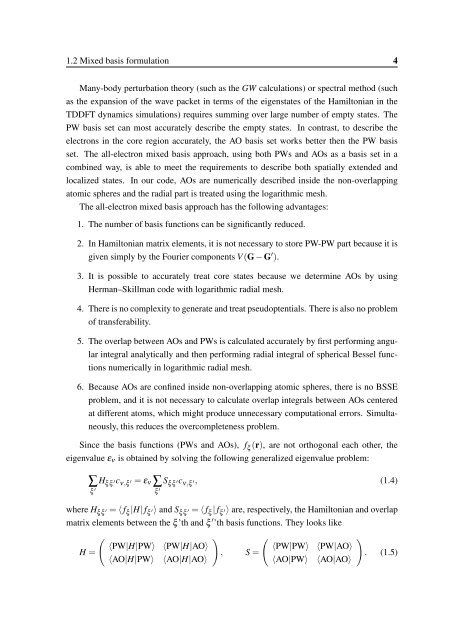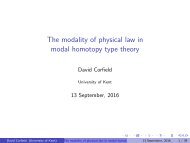TOMBO Ver.2 Manual
TOMBO
TOMBO
You also want an ePaper? Increase the reach of your titles
YUMPU automatically turns print PDFs into web optimized ePapers that Google loves.
1.2 Mixed basis formulation 4<br />
Many-body perturbation theory (such as the GW calculations) or spectral method (such<br />
as the expansion of the wave packet in terms of the eigenstates of the Hamiltonian in the<br />
TDDFT dynamics simulations) requires summing over large number of empty states. The<br />
PW basis set can most accurately describe the empty states. In contrast, to describe the<br />
electrons in the core region accurately, the AO basis set works better then the PW basis<br />
set. The all-electron mixed basis approach, using both PWs and AOs as a basis set in a<br />
combined way, is able to meet the requirements to describe both spatially extended and<br />
localized states. In our code, AOs are numerically described inside the non-overlapping<br />
atomic spheres and the radial part is treated using the logarithmic mesh.<br />
The all-electron mixed basis approach has the following advantages:<br />
1. The number of basis functions can be significantly reduced.<br />
2. In Hamiltonian matrix elements, it is not necessary to store PW-PW part because it is<br />
given simply by the Fourier components V (G − G ′ ).<br />
3. It is possible to accurately treat core states because we determine AOs by using<br />
Herman–Skillman code with logarithmic radial mesh.<br />
4. There is no complexity to generate and treat pseudoptentials. There is also no problem<br />
of transferability.<br />
5. The overlap between AOs and PWs is calculated accurately by first performing angular<br />
integral analytically and then performing radial integral of spherical Bessel functions<br />
numerically in logarithmic radial mesh.<br />
6. Because AOs are confined inside non-overlapping atomic spheres, there is no BSSE<br />
problem, and it is not necessary to calculate overlap integrals between AOs centered<br />
at different atoms, which might produce unnecessary computational errors. Simultaneously,<br />
this reduces the overcompleteness problem.<br />
Since the basis functions (PWs and AOs), f ξ (r), are not orthogonal each other, the<br />
eigenvalue ε ν is obtained by solving the following generalized eigenvalue problem:<br />
∑H ξ ξ ′c ν,ξ ′ = ε ν ∑S ξ ξ ′c ν,ξ ′, (1.4)<br />
ξ ′ ξ ′<br />
where H ξ ξ ′ = ⟨ f ξ |H| f ξ ′⟩ and S ξ ξ ′ = ⟨ f ξ | f ξ ′⟩ are, respectively, the Hamiltonian and overlap<br />
matrix elements between the ξ ’th and ξ ′ ’th basis functions. They looks like<br />
H =<br />
(<br />
⟨PW|H|PW⟩<br />
⟨AO|H|PW⟩<br />
⟨PW|H|AO⟩<br />
⟨AO|H|AO⟩<br />
)<br />
, S =<br />
(<br />
⟨PW|PW⟩<br />
⟨AO|PW⟩<br />
⟨PW|AO⟩<br />
⟨AO|AO⟩<br />
)<br />
. (1.5)



